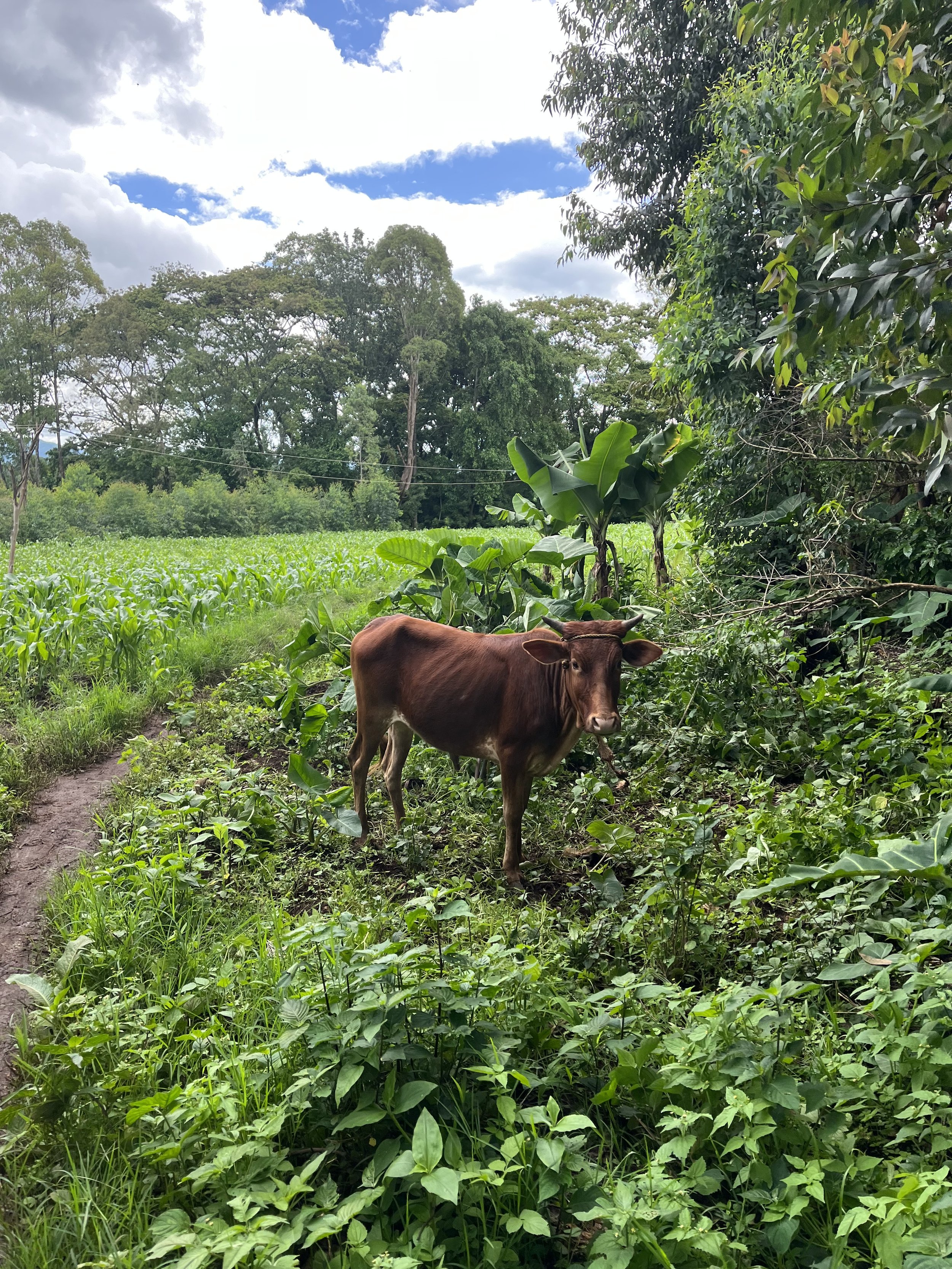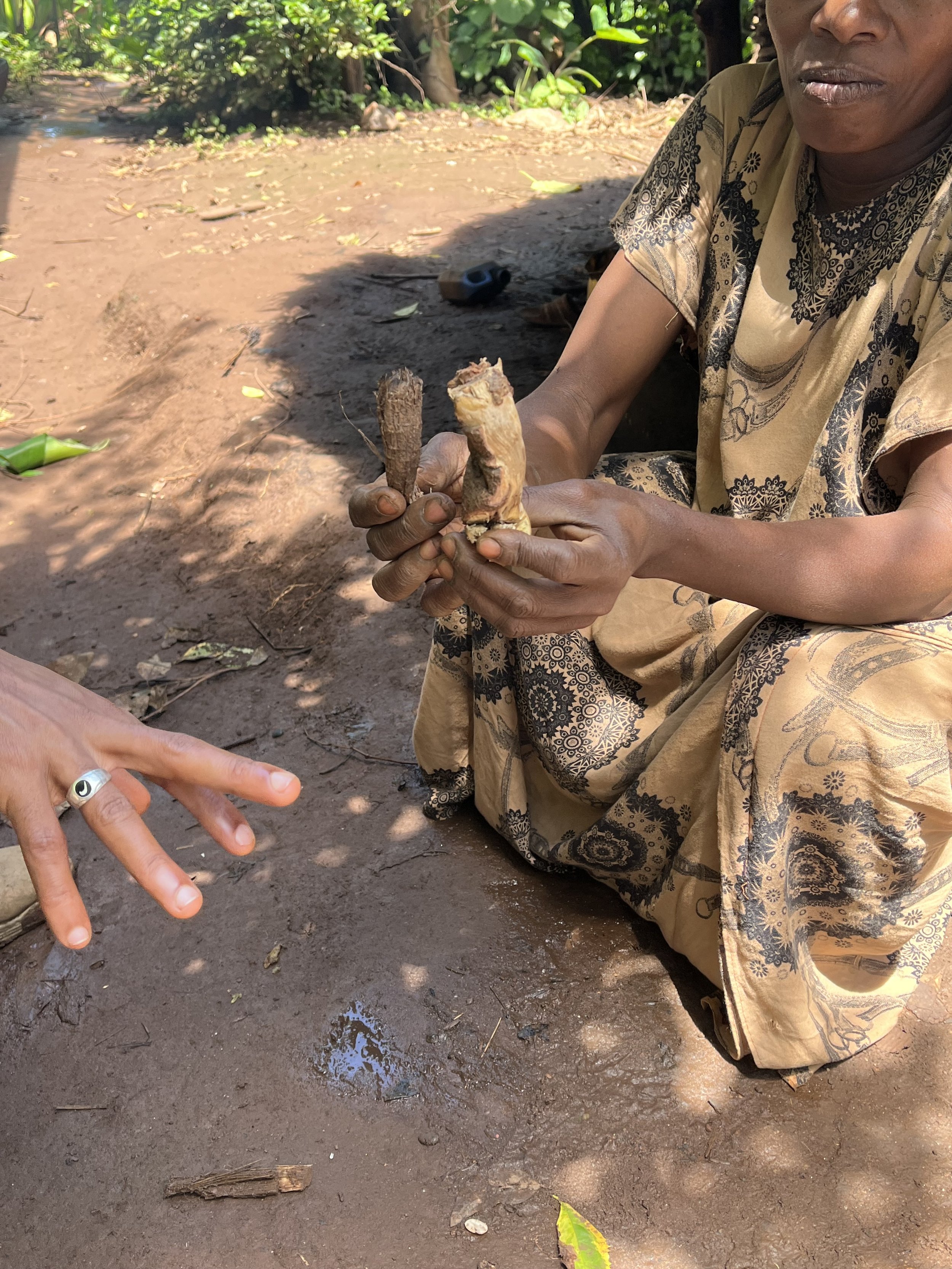“It Takes a Village” | Communal Healing in Yetna Birsh, Ethiopia
Nestled in the lush green mountainside 30 minutes North of Jinka in the Southern Omo valley is a small village by the name of Yetna birsh. Home to several healers with each their own specialty, Sago Journal spends the afternoon learning about the various forms of healing plants and practices of this tight-nit community.
Ayiht Bari crushes a plant and it’s seeds in her hands, demonstrating it’s use for tooth pain.
The motorbikes veer off from the main road, entering a small dirt path. Last night’s rainfall has left the path so muddy that we must unmount the motorcycles in order to trek deeper into the lush vegetation that envelops us. The surrounding mountains are teeming with life and the air is balmy, humidity gently coating the plants sprouting all around us. The rains have come a month earlier than anticipated this year, showering the valley in heavy rain, fertility, and bountifulness.
Siraj, a Jinka native of Ari origin, is our guide for the day. A tall lanky man with a jolly sense of humor, we were introduced to Siraj by Mr. Sintayu, director of the Lower Omo Natural Medicine Association (LONMA). A nature lover and member of LONMA, Siraj has previously accompanied Mr. Sintayu on various research trips documenting endemic medicinal plants and healers across Southern Omo Valley. Today however, we are visiting Siraj’s community to learn about traditional healing practices in an Ari community. Situated about 7 kms away from Jinka, we find ourselves in Getna Birsh, a small Ari village in the Omo Valley region of Ethiopia, a place home to a number of indigenous ethnic tribes, known for their portrayal in photos, as many have kept their traditional garb.
Passing motorbikers on the ride to Yetna Birsh from Jinka.
We follow the small dirt path up the hill and into a clearing where we meet our hosts. We are greeted first by an adorable girl gang, wide eyed and curious about the faranjis (foreigners) that have come to visit their community. Warm smiles and shrieks fill the air as Siraj parks the muddy bike in the corner of the compound, and after curiously inspecting us, the four girls run towards him, wrapping their small arms around his tall and tall figure in turns. Siraj embraces each of them individually with the familiarity of an uncle, before exchanging greetings in Ari, the local language, with the surrounding adults. Though Siraj is from the next door village on the other side of the hill, he knows this family well.
Today, we will have the chance to meet various people of the community, each with their own distinct knowledge of the medicinal plants growing in this area. Though many of the medicinal plants used are grown across the community, some are also purchased from the market, coming from other distant communities and ethnic groups, and used for both medicinal and spiritual purposes.
Wooden stools are settled under the shade of the foliage that covers the courtyard of the homestead and we are urged to sit down. Siraj sits beside us and begins to speak to one of the women inside a low and dark hut brimming with smoke, where she has been brewing Arake, a traditional liquor made from sorghum, to sell. Emerging from the smoky hut, her kind face is revealed. She crouches down beside us and opens her palms to reveal two pieces of bark.
“These are medicines to protect against the evil eye. This one is t’charma “(left, larger bark) and this one is “tcharagma” (right, smaller bark). To be free from it {the evil eye}, there are two medicines. One is used as an incense, the other is in powder form. We use this when someone has been possessed by the evil eye, when they are behaving crazy.”
Our morning will be spent like this, following different healers of the Ari community, kind souls who were eager to impart their knowledge of the plants that surrounded them. Although our first encounter centered more around root products used for the evil eye, the rest of the day ended up more of an exploration in the forest and gardens that surround us as the healers showed us the plants they used to heal various illnesses and woes.
Later, Ayiht Bari, a grandmother of several of the young girls who greeted us when we arrived, shows us around her garden, enthusiastically plucking the botanical beauties which each individually encapsulate an array of curative properties. Pulling out several leaves from an inconspicuous shrub, Ayiht begins to grind the leaves between her corse, strong fingers forming a darker and darker green ball.
Then gently, as the ball begins to form into one green mass, and leaves are no longer distinguishable from one another. Gesturing for a palm to be offered, she squeezes the rolled green mass over outstretched palm, and a single droplet of green liquid oozes out. This, she explains, is used for fever, then immediately begins foraging in her garden for another piece of herbal magic.
All around us are natural elements to prevent, heal and cure various ailments. Wonder and fascination take over being in this grandmother's garden who uses these remedies on a daily basis to care for her children and step-children. Ayiht is warm, welcoming - we don’t share a language to communicate with words, but her good intention is felt through her radiant smile, and an eagerness to explain her knowledge. It is easy to imagine how she collects and gathers these herbs to care for her family and members of her community.
Afterwards, we continue on to another little compound, following Siraj through the foliage. Zem Zem, a tall woman with a strong posture greets us and beckons us to follow her to the back of her compound, giving way to a little clearing with a pathway. Zem Zem walks along the pathway with us in tow, gesturing to the shrubs lining the dirt path. Another array of plants are presented to us, different from the others, treating different diseases and infections - herpes, stomach problems, diarrhea, rabies, tapeworm, and sexually transmitted infections.
Zem Zem, crunches together a bundle of leaves and holds them up to her nose before urging us to smell the sweet earthy scent.
“This is used when the penis is infected outside and fluid comes out,” Siraj translates, gesturing to a small shrub in the ground. Little more is said about the magical penis plant, and we continue trudging along.
Root bark used to treat snake bite wounds.
Along the path we also meet a man with a handicap that has paralyzed his legs, maneuvering using his arms. Us in tow, he hobbles to his garden, just a stone's throw from Zem Zem’s house, and begins to dig up the root of a plant.
“Here, for snake bites,” he says, hanging us a small plant with a long root.
We continue to follow Zem Zem, who stops every couple of meters to show us another plant with yet another virtue. The foliage surrounding is indeed a true pharmacopeia, where the green abundance heals the humans who in return tend and care for the land around them. Land & knowledge are deeply intertwined within this context, with each healer cultivating a different pharmacology to support their loved ones. Herbs, barks, medicines are grown locally - right in one’s backyard, but equally sourced from the Northern regions of the country. Bodies become repositories of knowledge and practice, an interwoven web of specialized knowledge sustained through community - I heal this, you heal that.
The practice of “healer” in Yetna Birsh extends itself to the very community, where networks of healing thrive by supporting each other, in collaborative plurality.
A warm thank you to Siraj & Mr.Sintayu for facilitating introductions and bringing the Sago team to Yetna Birsh to meet the healers & knowers of this community.
A special thank you to Siraj for his support with translation.









